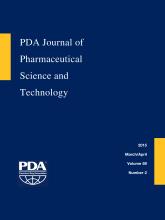Article CommentaryCommentary
Emerging Contaminants: A Potential Human Health Concern for Sensitive Populations
Kiranmayi P. Mangalgiri, Ke He and Lee Blaney
PDA Journal of Pharmaceutical Science and Technology March 2015, 69 (2) 215-218; DOI: https://doi.org/10.5731/pdajpst.2015.01034
Kiranmayi P. Mangalgiri
University of Maryland Baltimore County Department of Chemical, Biochemical and Environmental Engineering, Baltimore, MD 21250
Ke He
University of Maryland Baltimore County Department of Chemical, Biochemical and Environmental Engineering, Baltimore, MD 21250
Lee Blaney
University of Maryland Baltimore County Department of Chemical, Biochemical and Environmental Engineering, Baltimore, MD 21250

References
- 1.↵
- Kolpin D. W.,
- Furlong E. T.,
- Meyer M. T.,
- Thurman E. M.,
- Zaugg S. D.,
- Barber L. B.,
- Buxton H. T.
- 2.↵
- Collier A.
- 3.↵
- Schulman L. J.,
- Sargent E. V.,
- Naumann B. D.,
- Faria E. C.,
- Dolan D. G.,
- Wargo J. P.
- 4.↵
- 5.↵
- Yergeau E.,
- Sanschagrin S.,
- Waiser M. J.,
- Lawrence J. R.,
- Greer C. W.
- 6.↵
- Richardson M. L.,
- Bowron J. M.
- 7.↵
- Croes K.,
- Colles A.,
- Koppen G.,
- Govarts E.,
- Bruckers L.,
- Van de Mieroop E.,
- Nelen V.,
- Covaci A.,
- Dirtu A. C.,
- Thomsen C.,
- Haug L. S.,
- Becher G.,
- Mampaey M.,
- Schoeters G.,
- Van Larebeke N.,
- Baeyens W.
- 8.↵
- 9.↵
- Schlumpf M.,
- Kypke K.,
- Vökt C. C.,
- Birchler M.,
- Durrer S.,
- Faass O.,
- Ehnes C.,
- Fuetsch M.,
- Gaille C.,
- Henseler M.,
- Hofkamp L.,
- Maerkel K.,
- Reolon S.,
- Zenker A.,
- Timms B.,
- Tresguerres J. A. F.,
- Lichtensteigera W.
- 10.↵
- Marshall J.,
- Ng J.
- 11.↵
- Main K. M.,
- Mortensen G. K.,
- Kaleva M. M.,
- Boisen K. A.,
- Damgaard I. N.,
- Chellakooty M.,
- Schmidt I. M.,
- Suomi A.-M.,
- Virtanen H. E.,
- Petersen J. H.
- 12.↵
- 13.↵
- 14.↵
- 15.↵
- Oaks J. L.,
- Gilbert M.,
- Virani M. Z.,
- Watson R. T.,
- Meteyer C. U.,
- Rideout B. A.,
- Shivaprasad H. L.,
- Ahmed S.,
- Iqbal Chaudhry M. J.,
- Arshad M.,
- Mahmood S.,
- Ali A.,
- Khan A. A.
- 16.↵
- Kidd K. A.,
- Blanchfield P. J.,
- Mills K. H.,
- Palace V. P.,
- Evans R. E.,
- Lazorchak J. M.,
- Flick R. W.
- 17.↵
- 18.↵
- Boxall A.,
- Rudd M. A.,
- Brooks B. W.,
- Caldwell D. J.,
- Choi K.,
- Hickmann S.,
- Innes E.,
- Ostapyk K.,
- Staveley J. P.,
- Verslycke T.
- 19.↵
- González-Pleiter M.,
- Gonzalo S.,
- Rodea-Palomares I.,
- Leganés F.,
- Rosal R.,
- Boltes K.,
- Marco E.,
- Fernández-Piñas F.
- 20.↵
- Enright H.,
- Lao V.,
- Falso M. S.,
- Buchholz B.,
- Kulp K.,
- Bench G.,
- Malfatti M.,
- Turteltaub K.
- 21.↵
- Khetan S. K.,
- Collins T. J.
- 22.↵
- 23.↵
- 24.↵
- 25.↵
- Glassmeyer S. T.,
- Hinchey E. K.,
- Boehme S. E.,
- Daughton C. G.,
- Ruhoy I. S.,
- Conerly O.,
- Daniels R. L.,
- Lauer L.,
- McCarthy M.,
- Nettesheim T. G.,
- Sykes K.,
- Thompson V. G.
- 26.↵
- Braund R.,
- Peake B. M.,
- Shieffelbien L.
In This Issue
PDA Journal of Pharmaceutical Science and Technology
Vol. 69, Issue 2
March/April 2015
Emerging Contaminants: A Potential Human Health Concern for Sensitive Populations
Kiranmayi P. Mangalgiri, Ke He, Lee Blaney
PDA Journal of Pharmaceutical Science and Technology Mar 2015, 69 (2) 215-218; DOI: 10.5731/pdajpst.2015.01034
Jump to section
Related Articles
- No related articles found.





